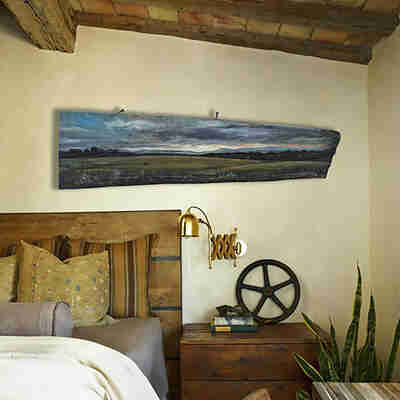About the author
The work of the artist and designer Ekaterina Kukhareva is diverse. She works with different materials, creating paintings on canvas, paper, from colored sheep's wool, but her favorite technique is painting on boards. She got interested in this material back in the late 1990s.
It all started prosaically - from limited funds for the purchase of art materials during his student years.
Studying at the Faculty of Applied Arts of the Moscow Textile Academy. A. N. Kosygina, which she graduated with honors, Ekaterina painted mainly in tempera and watercolors, and began to work in oils in her free time. The first oil paints went to Catherine from her mother, who had artistic abilities, but was not professionally engaged in painting.
The aspiring artist worked in her parents' country house, which had not yet been completed. Therefore, there were a lot of scraps of boards and plywood, which Catherine first used as palettes, but then one day she decided that she did not want to spend the family's money on canvas and primed cardboard. "Why, when there are so many free boards around that no one needs anymore?" - says the author. This is how it all started.
The artist experimented with wood and after a few years came to the author's technique, which consists in a certain sequence of stages of work so that the picture looks vintage, worn, but at the same time the paint and varnish were well fixed. Over time, Ekaterina moved from small-format works to larger ones. The artist uses pine, birch, eucalyptus, ash and other species that he can find in his work.
But the most important thing that distinguishes Catherine's work from the work of other artists who write on blackboards is that she uses such a psychological phenomenon as pareidolia at the beginning of her work. Pareidolia is a kind of visual illusion, when the details of inanimate objects are transformed in our imagination into images of people, animals, figures, landscapes. In the drawing of wallpaper, on a cut of stone or wood, in the form of clouds or rocks, in the details of buildings or cars - everywhere you can see how the manifestation of pareidolia is different faces and figures. This feature of our visual perception is often used by street artists, inscribing their characters in the urban environment, using fragments of buildings and details of engineering structures as part of their image, while filling it with meaning.
When Catherine starts work, she first prepares the board: she polishes, impregnates with special compounds, and then decides on which side of the board she will work.
The artist's works are often symbolic and not always written from life. One of the characteristic techniques in Ekaterina Kukhareva's painting is to leave a part of the board not covered with paint or wipe it down to the bottom layer of paint or to the tree itself. This gives the work a special charm.
Among the artist's paintings there are also two-sided works, which makes them especially interesting. Also, one of the features of the artist's work is that she often writes on the sides of the board. Her paintings do not need to be framed; they can not only be mounted on the wall, but also placed on shelves and furniture.
“Those who revolutionized art are certainly great people. Many of them are my compatriots, famous all over the world, of which I am especially proud. I do not pretend to “say a new word in art”, but I think that my direction is interesting because each work is unique and inimitable, because the soul of this tree speaks in it. One hundred different artists can paint on a standard format canvas. Then you can make copies of these pictures. And it is impossible to copy my paintings, since the second such board simply no longer exists in nature. The wood base itself is unique. Canvas is not a unique basis, ”concludes Ekaterina.
Planks were one of the earliest foundations for artists until the spread of free-spanning canvas in the 17th century. But that was exactly the foundation. The boards were carefully selected so that there were no defects, cracks, knots. For Catherine, the presence of cracks, holes, traces of bark beetle, scratches on the boards is valuable. This is the real, true story of the tree. In addition, the tree has its own special smell, energy, it is pleasant to touch it. It is warm, which cannot be said about the canvas. Therefore, the artist's paintings are perceived best when you take them in your hands.
Currently, the artist continues to experiment with wood and other materials. There are plans for projects in the field of integral art.
"I have always liked the forests of Russia," - Ekaterina admitted, - " so I prefer wood as a material and planks as a woodworking product. Slabs retain the warmth, soul and energy of a living tree. Look at my works and you will see what came out of our dialogue with them".
Rustic interior design

18/01/2021
